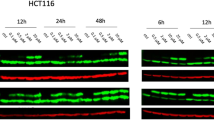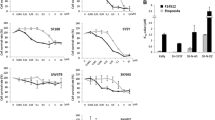Abstract
Purpose: The cytotoxicity of the thymidylate synthase (TS) inhibitor raltitrexed (RTX) is reversed by supraphysiologic thymidine concentrations. Dipyridamole (DP) blocks thymidine salvage (uptake) and potentiates several chemotherapeutic agents in vitro. The purpose of this study was to determine whether DP is capable of potentiating RTX cytotoxicity in the presence of physiologic thymidine concentrations. Methods: We examined the effect of DP on RTX cytotoxicity in the presence of various physiologic thymidine concentrations in eight colorectal adenocarcinoma cell lines by colony formation assay, and in p53-defective HL60 S and p53-competent HL60 SN3 promyelocytic leukemia cells by a tetrazolium reduction-based assay. Results: In WiDr colon adenocarcinoma cells the cytotoxicity of 1.0 μM RTX (4 h) varied from 0% to >99% within the reported range of human serum thymidine concentrations from 500 to <50 nM, respectively. DP potentiated RTX cytotoxicity 2- to >93-fold within this range. Free DP concentrations of 10 to 20 nM, achievable with oral dosing, potentiated RTX at thymidine concentrations up to 100 nM. Potentiation at higher physiologic thymidine concentrations of ≥200 nM required DP concentrations of at least 50 nM, or about twice the steady-state DP concentration obtainable from oral and intravenous dosing, but well within that obtainable by intraperitoneal infusion. Maximal potentiation required 72 to 120 h of DP exposure. DP also potentiated RTX in the absence of exogenous thymidine in six of eight colon cell lines and HL60 S and SN3 cells suggesting a second, nonthymidine salvage-dependent mechanism of potentiation. Conclusions: Clinically achievable free DP concentrations potentiated RTX cytotoxicity within the range of physiologic serum thymidine concentrations. RTX/DP or DP analogue-based combination therapy should, therefore, be considered for clinical trial. Serum or tumor thymidine concentration determinations may aid in identification of patients likely to respond to TS and nucleoside salvage inhibitors versus alternate, non-TS-directed therapies.
Similar content being viewed by others
Author information
Authors and Affiliations
Additional information
Received: 22 March 1999 / Accepted: 13 August 1999
Rights and permissions
About this article
Cite this article
Lehman, N., Danenberg, P. Modulation of RTX cytotoxicity by thymidine and dipyridamole in vitro: implications for chemotherapy. Cancer Chemother Pharmacol 45, 142–148 (2000). https://doi.org/10.1007/s002800050022
Issue Date:
DOI: https://doi.org/10.1007/s002800050022




